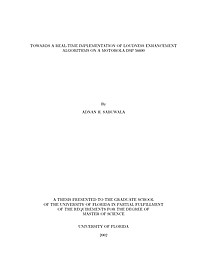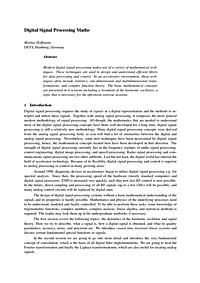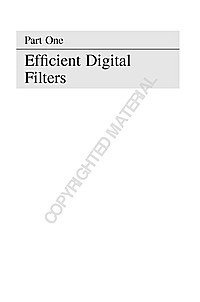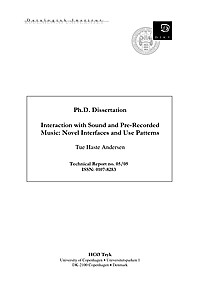An application of neural networks to adaptive playout delay in VoIP
The statistical nature of data traffic and the dynamic routing techniques employed in IP networks results in a varying network delay (jitter) experienced by the individual IP packets which form a VoIP flow. As a result voice packets generated at successive and periodic intervals at a source will typically be buffered at the receiver prior to playback in order to smooth out the jitter. However, the additional delay introduced by the playout buffer degrades the quality of service. Thus, the ability to forecast the jitter is an integral part of selecting an appropriate buffer size. This paper compares several neural network based models for adaptive playout buffer selection and in particular a novel combined wavelet transform/neural network approach is proposed. The effectiveness of these algorithms is evaluated using recorded VoIP traces by comparing the buffering delay and the packet loss ratios for each technique. In addition, an output speech signal is reconstructed based on the packet loss information for each algorithm and the perceptual quality of the speech is then estimated using the PESQ MOS algorithm. Simulation results indicate that proposed Haar-Wavelets-Packet MLP and Statistical-Model MLP adaptive scheduling schemes offer superior performance.
HIERARCHICAL MOTION ESTIMATION FOR EMBEDDED OBJECT TRACKING
This paper presents an algorithm developed to provide automatic motion detection and object tracking embedded within intelligent CCTV systems. The algorithm development focuses on techniques which provide an efficient embedded systems implementation with the ability to target both FPGA and DSP devices. During algorithm development constraints on hardware implementation have been fully considered resulting in an algorithm which, when targeted at current FPGA devices, will take full advantage of the DSP resource commonly provided in such devices. The hierarchical structure of the proposed algorithm provides the system with a multi-level motion estimation process allowing low resolution estimation for motion detection and further higher resolution stages for motion estimation. An initial MATLAB prototype has demonstrated this algorithm capable of object motion estimation while compensating for camera motion, allowing a moving object to be tracked by a moving camera.
An FPGA Implementation of Hierarchical Motion Estimation for Embedded Oject Tracking
This paper presents the hardware implementation of an algorithm developed to provide automatic motion detection and object tracking functionality embedded within intelligent CCTV systems. The implementation is targeted at an Altera Stratix FPGA making full use of the dedicated DSP resource. The Altera Nios embedded processor provides a platform for the tracking control loop and generic Pan Tilt Zoom camera interface. This paper details the explicit functional stages of the algorithm that lend themselves to an optimised pipelined hardware implementation. This implementation provides maximum data throughput, providing real-time operation of the described algorithm, and enables a moving camera to track a moving object in real time.
A DGPS/Radiobeacon Receiver for Minimum Shift Keying with Soft Decision Capabilities
The Global Positioning System (GPS) is now in operation, and many improvements to its performance are being sought. One such improvement is Differential GPS (DGPS), where known errors in the GPS broadcast are identified and the corrections broadcast to the end user. One implementation of DGPS being considered is the use of coastal marine radio direction finding (RDF) radiobeacons in the 285-325kHz band as transmitters for the DGPS broadcast. The normal RDF beacon signal consists of a continuous carrier on a one kilohertz boundary plus a Morse-code identification signal 1025Hz above the carrier. In the DGPS/radiobeacon implementation proposed for the US coastal regions, the differential data link signal uses minimum shift keying (MSK) at a data rate of 25, 50, 100, 200 or 400 baud (the exact baud rat has not yet been decided). This MSK signal is centered between the RDF beacon carrier and identification signal. At the frequencies that these radiobeacons are operated, the prevailing atmospheric noise is both non-Gaussian and very strong. This noise characteristic makes the design of a long-range data link difficult. One solution that has been proposed is the use of forward error correction (FEC) coding of the data. The performance of FEC decoders can be improved by the used of a soft decision receiver, which delivers both bit decisions and information about the validity of the bit decisions. This work describes the design of a radio receiver for DGPS/Radiobeacon servics which is capable of reception of 400 baud MSK in the DGPS/Radiobeacon band. The receiver is designed to be easily augmented to provide soft decisions and easily modified to recieve MSK at data rates of 25 to 400 baud. The radio is a microprocessor controlled dual conversion superheterodyne with an audio frequency of 1kHz. The demodulator runs on the same microprocessor that controls the radio. The weak-signal performance of the demodulator is very good: the Eb/No vs. bit error rate performance of the demodulator is only a couple of dB worse than the theoretical performance of differential phase-shift keying. The radio has a noise floor of -114dBm referenced to it's 500Hz wide audio bandwidth and a 3rd order intermodulation intercept of +7dBm for a dynamic range of 83dB. This work concludes with a thumbnail analysis of the operations needed to implement a soft bit decision estimator, and some suggestions for the implementation of said soft bit decision estimator.
IMPLEMENTATION OF PERIODOGRAM SMOOTHING OF NOISYIMPLEMENTATION OF PERIODOGRAM SMOOTHING OF NOISY SIGNALS USING TMS320C6713 DSK
Periodogram Smoothing is a technique of power spectrum estimation. The discrete Fourier transform of a digital signal simply resolves the frequency components. The algorithm is implemented on Texas Instruments’ TMS320C6713 DSP Starter Kit (DSK). This is a 32-bit floating-point digital signal processor running at 225 MHz. The programs are basically written in the C programming language. However, those sections of code which are time-critical and memory-critical are written in assembly language of C6713. A MATLAB™ graphical user interface is also provided. The MATLAB™ program calls C programs loaded in Code Composer Studio (CCS). The C programs in turn call the assembly programs when required.

Hidden Markov Model based recognition of musical pattern in South Indian Classical Music
Automatic recognition of musical patterns plays a crucial part in Musicological and Ethno musicological research and can become an indispensable tool for the search and comparison of music extracts within a large multimedia database. This paper finds an efficient method for recognizing isolated musical patterns in a monophonic environment, using Hidden Markov Model. Each pattern, to be recognized, is converted into a sequence of frequency jumps by means of a fundamental frequency tracking algorithm, followed by a quantizer. The resulting sequence of frequency jumps is presented to the input of the recognizer which use Hidden Markov Model. The main characteristic of Hidden Markov Model is that it utilizes the stochastic information from the musical frame to recognize the pattern. The methodology is tested in the context of South Indian Classical Music, which exhibits certain characteristics that make the classification task harder, when compared with Western musical tradition. Recognition of 100% has been obtained for the six typical music pattern used in practise. South Indian classical instrument, flute is used for the whole experiment.

Design and implementation of odd-order wave digital lattice lowpass filters, from specifications to Motorol DSP56307EVM module
This thesis is dedicated to applying and developing explicit formulas for the design and implementation of odd-order lattice Lowpass wave digital filters (WDFs) on a Digital Signal Processor (DSP), such as a Motorola DSP56307EVM (Evaluation Module). The direct design method of Gazsi for filter types such as Butterworfh, Chebyshev, inverse Chebyshev, and Cauer (Elliptic) provides a straightforward method for calculating the coefficients without an extensive knowledge of digital signal processing. A program package to design and implement odd-order WDFs, including detailed procedures and examples, is presented in this thesis and includes not only the calculations of the coefficients, but also the simulation on a MATLAB platform and an implementation on a Motorola DSP56307EVM board. It is very quick, effective and convenient to obtain the coefficients when the user enters a few parameters according to the general specifications; to verify the characteristics of the designed filter; to simulate the filter on the MATLAB platform; to implement the filter on the DSP board; and to compare the results between the simulation and the implementation.

Implementing IS-95, the CDMA Standard, on TMS320C6201 DSP
IS-95 is the present U.S. 2nd generation CDMA standard. Currently, the 2nd generation CDMA phones are produced by Qualcomm. Texas Instruments (TI) has ASIC design for Viterbi Decoder on C54x. Several of the components in the forward link process are also implemented in hardware. However, having to design a specific hardware for a particular application is expensive and time consuming. Thus, the possibility of the alternative implementations is of great interest to both customers and TI itself. This research has achieved in successful implementation of IS-95 entirely in software on TI fixed-point DSP TMS320C6201, and met the real time constraint. IS-95 system, the industrial standard for CDMA, is a very complicated system and extremely computationally demanding. The transmission rate for an IS-95 system is 1.2288 Mcps. This research project includes all the major components of the demodulation process for the forward link system: PN Descrambling, Walsh Despreading, Phase Correction & Maximal Ratio Combining, Deinterleaver, Digital Automatic Gain Control, and Viterbi Deccc:r. The entire demodulation process is done completely in C. That makes it a very attractive alternative implementation in the future applications. It is well known that ASIC design is not only expensive and but also time consuming, programming in assembly is easier and cheaper, but programming in C is a much easier and efficient way out, in particular, for general computer engineers. During the whole process, efforts have been devoted on developing various specific techniques to optimize the design for all the components involved. These developments are successfully achieved by making the best use of the following techniques: to simplify the algorithms first before programming, to look for regularity in the problem, to work toward the Compiler's full efficiency, and to use C intrinsics whenever possible. All these attributes together make the implementation scheme great for DSP applications. The benchmark results compare very well to the TI-internal hand scheduled assembly performance of the same type of decoders. The estimated percentage usage of all the components (excluding PN) is only 21.18% of the total CPU cycles available (4,000 K), which is very efficient and impressive.

Towards a Real-Time Implementation of Loudness Enhancement Algorithms on a Motorola DSP 56600
Most of the cellular phone companies with audio speaker capabilities focus on reducing the current drain to extend battery life. None of these companies concentrate on modifying the speech signal itself to make it sound louder in noisy listener environments without adding additional energy. Such algorithms have been described in literature by Boillot and form the backbone of this thesis. The current project focusses on taking a step towards running these algorithms in real-time on a 16-bit fixed point Motorola DSP 56600. Implementation of the autocorrelation, Levinson- Durbin, FIR, and IIR filters in assembly for the Motorola DSP 56600 has been investigated in the thesis. The challenges and alternate solutions to circumvent the challenges have been described, and experimental results have been presented. Results indicate that the modified signed LMS algorithm, which can be considered to be a blend between the LMS and signed LMS algorithms, turns out to be an elegant solution to circumvent the challenges in implementing the Levinson-Durbin recursion.

An Advanced Signal Processing Toolkit for Java applications
The aim of this study is to examine the capability, performance, and relevance of a signal processing toolkit in Java, a programming language for Web-based applications. Due to the simplicity, ease and application use of the toolkit and with the advanced Internet technologies such as Remote Method Invocation (RMI), a spectral estimation applet has been created in the Java environment. This toolkit also provides an interactive and visual approach in understanding the various theoretical concepts of spectral estimation and shows the need to create more application applets to better understand the various concepts of signal and image processing. This study also focuses on creating a Java toolkit for embedded systems, such as Personal Digital Assistants (PDAs), embedded Java board, and supporting integer precision, and utilizing COordinate Rotation DIgital Computer (CORDIC) algorithm, both aimed to provide good performance in resource-limited environments. The results show a feasibility and necessity of developing a standardized Application Programming Interface (API) for the fixed-point signal processing library.

Digital Signal Processing Maths
Modern digital signal processing makes use of a variety of mathematical techniques. These techniques are used to design and understand efficient filters for data processing and control.

Restoration of Nonlinearly Distorted Optical Soundtracks Using Regularized Inverse Characteristics
This dissertation is concerned with the possibilities of restoration of degraded film-sound. The sound-quality of old films are often not acceptable, which means that the sound is so noisy and distorted that the listener have to take strong efforts to understand the conversations in the film. In this case the film cannot give artistic enjoyment to the listener. This is the reason that several old films cannot be presented in movies or television. The quality of these films can be improved by digital restoration techniques. Since we do not have access to the original signal, only the distorted one, therefore we cannot adjust recording parameters or recording techniques. The only possibility is to post-compensate the signal to produce a better estimate about the undistorted, noiseless signal. In this dissertation new methods are proposed for fast and efficient restoration of nonlinear distortions in the optically recorded film soundtracks. First the nonlinear models and nonlinear restoration techniques are surveyed and the ill-posedness of nonlinear post-compensation (the extreme sensitivity to noise) is explained. The effects and sources of linear and nonlinear distortions at optical soundtracks are also described. A new method is proposed to overcome the ill-posedness of the restoration problem and to get an optimal result. The effectiveness of the algorithm is proven by simulations and restoration of real film-sound signals.

Fundamentals of the DFT (fft) Algorithms
In this article, a physical explanation of the fundamentals of the DFT (fft) algorithms is presented in terms of waveform decomposition. After reading the article and trying the examples, the reader is expected to gain a clear understanding of the basics of the mysterious DFT (fft) algorithms.

Efficient Digital Fiilters
What would you do in the following situation? Let ’ s say you are diagnosing a DSP system problem in the field. You have your trusty laptop with your development system and an emulator. You figure out that there was a problem with the system specifications and a symmetric FIR filter in the software won ’ t do the job; it needs reduced passband ripple, or maybe more stopband attenuation. You then realize you don ’ t have any filter design software on the laptop, and the customer is getting angry. The answer is easy: You can take the existing filter and sharpen it. Simply stated, filter sharpening is a technique for creating a new filter from an old one [1] – [3] . While the technique is almost 30 years old, it is not generally known by DSP engineers nor is it mentioned in most DSP textbooks.

Interaction with Sound and Pre-Recorded Music: Novel Interfaces and Use Patterns
Computers are changing the way sound and recorded music are listened to and used. The use of computers to playback music makes it possible to change and adapt music to different usage situations in ways that were not possible with analog sound equipment. In this thesis, interaction with pre-recorded music is investigated using prototypes and user studies. First, different interfaces for browsing music on consumer or mobile devices were compared. It was found that the choice of input controller, mapping and auditory feedback influences how the music was searched and how the interfaces were perceived. Search performance was not affected by the tested interfaces. Based on this study, several ideas for the future design of music browsing interfaces were proposed. Indications that search time depends linearly on distance to target were observed and examined in a related study where a movement time model for searching in a text document using scrolling was developed. Second, work practices of professional disc jockeys (DJs) were studied and a new design for digital DJing was proposed and tested. Strong indications were found that the use of beat information could reduce the DJ’s cognitive workload while maintaining flexibility during the musical performance. A system for automatic beat extraction was designed based on an evaluation of a number of perceptually important parameters extracted from audio signals. Finally, auditory feedback in pen-gesture interfaces was investigated through a series of informal and formal experiments. The experiments point to several general rules of auditory feedback in pen-gesture interfaces: a few simple functions are easy to achieve, gaining further performance and learning advantage is difficult, the gesture set and its computerized recognizer can be designed to minimize visual dependence, and positive emotional or aesthetic response can be achieved using musical auditory feedback.
An application of neural networks to adaptive playout delay in VoIP
The statistical nature of data traffic and the dynamic routing techniques employed in IP networks results in a varying network delay (jitter) experienced by the individual IP packets which form a VoIP flow. As a result voice packets generated at successive and periodic intervals at a source will typically be buffered at the receiver prior to playback in order to smooth out the jitter. However, the additional delay introduced by the playout buffer degrades the quality of service. Thus, the ability to forecast the jitter is an integral part of selecting an appropriate buffer size. This paper compares several neural network based models for adaptive playout buffer selection and in particular a novel combined wavelet transform/neural network approach is proposed. The effectiveness of these algorithms is evaluated using recorded VoIP traces by comparing the buffering delay and the packet loss ratios for each technique. In addition, an output speech signal is reconstructed based on the packet loss information for each algorithm and the perceptual quality of the speech is then estimated using the PESQ MOS algorithm. Simulation results indicate that proposed Haar-Wavelets-Packet MLP and Statistical-Model MLP adaptive scheduling schemes offer superior performance.
HIERARCHICAL MOTION ESTIMATION FOR EMBEDDED OBJECT TRACKING
This paper presents an algorithm developed to provide automatic motion detection and object tracking embedded within intelligent CCTV systems. The algorithm development focuses on techniques which provide an efficient embedded systems implementation with the ability to target both FPGA and DSP devices. During algorithm development constraints on hardware implementation have been fully considered resulting in an algorithm which, when targeted at current FPGA devices, will take full advantage of the DSP resource commonly provided in such devices. The hierarchical structure of the proposed algorithm provides the system with a multi-level motion estimation process allowing low resolution estimation for motion detection and further higher resolution stages for motion estimation. An initial MATLAB prototype has demonstrated this algorithm capable of object motion estimation while compensating for camera motion, allowing a moving object to be tracked by a moving camera.

Hidden Markov Model based recognition of musical pattern in South Indian Classical Music
Automatic recognition of musical patterns plays a crucial part in Musicological and Ethno musicological research and can become an indispensable tool for the search and comparison of music extracts within a large multimedia database. This paper finds an efficient method for recognizing isolated musical patterns in a monophonic environment, using Hidden Markov Model. Each pattern, to be recognized, is converted into a sequence of frequency jumps by means of a fundamental frequency tracking algorithm, followed by a quantizer. The resulting sequence of frequency jumps is presented to the input of the recognizer which use Hidden Markov Model. The main characteristic of Hidden Markov Model is that it utilizes the stochastic information from the musical frame to recognize the pattern. The methodology is tested in the context of South Indian Classical Music, which exhibits certain characteristics that make the classification task harder, when compared with Western musical tradition. Recognition of 100% has been obtained for the six typical music pattern used in practise. South Indian classical instrument, flute is used for the whole experiment.

A Two-Level Reconfigurable Cell Array for Digital Signal Processing
Reconfigurable hardware has become an attractive option for implementing digital signal processing, especially in systems that require both high performance and flexibility. This thesis presents a novel two-level reconfigurable architecture targeted toward systems with these requirements. The architecture supports a large orthogonal design space whereby designers can customize the word length, amount of parallelism, number of functional units, and functional unit connectivity to meet the needs of the application. On the upper level, algorithms are mapped onto an array of 4-bit cells and a hierarchical interconnection fabric. The interconnection structure contains a mesh of 4-bit busses for local data transfer, as well as an H-tree for communicating results between functional units. On the lower level, each cell contains a small matrix of elements that collectively implement all necessary operations. The matrix of elements has only two configurations: one optimized for mathematical functions such as multiply-accumulates, and the other optimized for memory operations. The system also contains pipeline latches to maximize clock rate and throughput. Circuit simulations indicate that the architecture achieves a clock frequency of 200 MHz in a modest 0.25-μm CMOS technology. An initial prototype of the reconfigurable cell has been fabricated in 0.5-μm CMOS and tested for functionality. The estimated execution time for a 16-bit, 256-point Fast Fourier Transform shows a speedup ranging from 1.6 to 14 compared to contemporary digital signal processors.
Efficient Signal Processing Techniques for Future Wireless Communications Systems
Wireless communications systems are evolving to be more diverse in use and more ubiquitous in nature. It is of fundamental importance that we consume the resources available in such systems, i.e., bandwidth and energy, to preserve room for more users and to preserve longevity. Signal processing can greatly help us achieve this. In this thesis we consider improving the utility of resources available in wireless communications systems. The basic obstacle for most wireless communications systems is the multipath channel that causes intersymbol interference. Channel estimation is a crucial step for recovering the transmitted symbols. Moreover, as more devices are equipped with wireless capabilities, the bandwidth becomes scarce and it is important to allow more than one device or more than one user to use the same frequency range or the same channel. However, this introduces multiuser interference, which is again eliminated only if the channel is known. Furthermore, most wireless systems are battery powered, at least at the transmitter end. Hence it is crucial that energy consumption is minimized to preserve the longevity of the system. The contribution of this thesis is three fold: (i) We propose novel bandwidth efficient blind channel estimation algorithms for single input multiple output systems, and for multiuser OFDM systems. The former exploits cyclostationarity inherent in communications signals. The latter exploits the structure introduced to the transmitted signal via precoding. We consider design of such precoders by optimizing performance metrics such as the bit error rate and signal to interference plus noise ratio. (ii) In the multiuser systems case, we propose a novel cooperative OFDM system and show that, when users face significantly different channel conditions, cooperation can improve the performance of all the cooperating users. (iii) We consider energy efficient training based system estimation in large MIMO systems. The goal there is to minimize energy consumption both in transmission of training symbols and in performing computations. We show that by using a divide and conquer strategy in selecting the active set of transmitters and receivers, it is possible to minimize energy consumption without degrading the accuracy of the channel estimate.



















